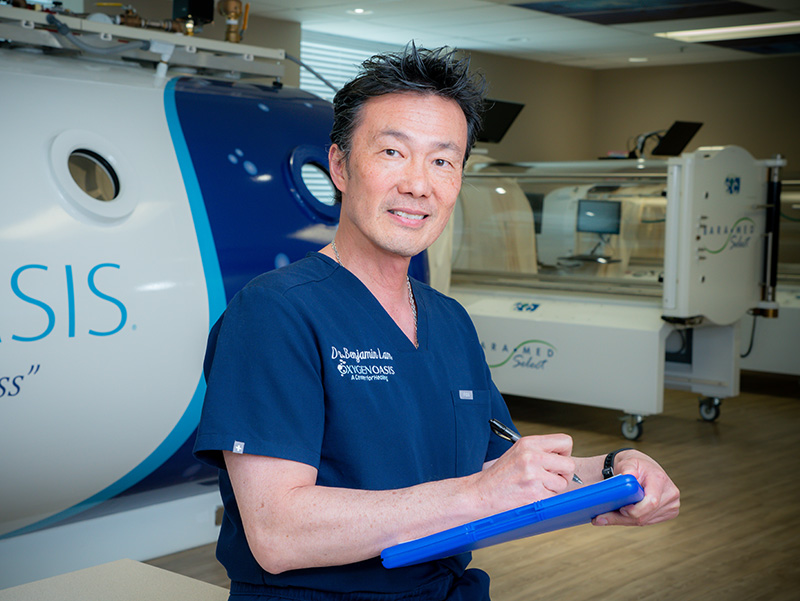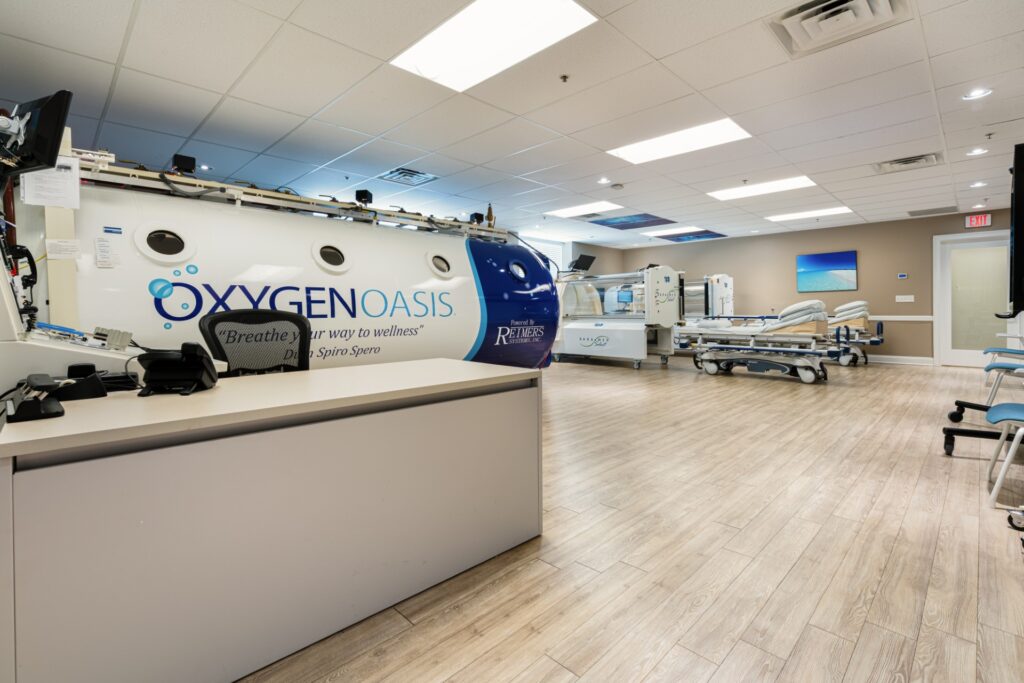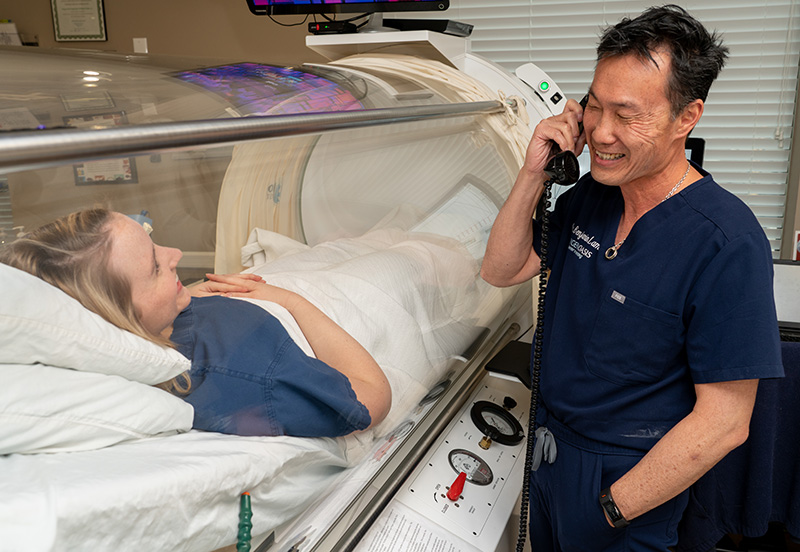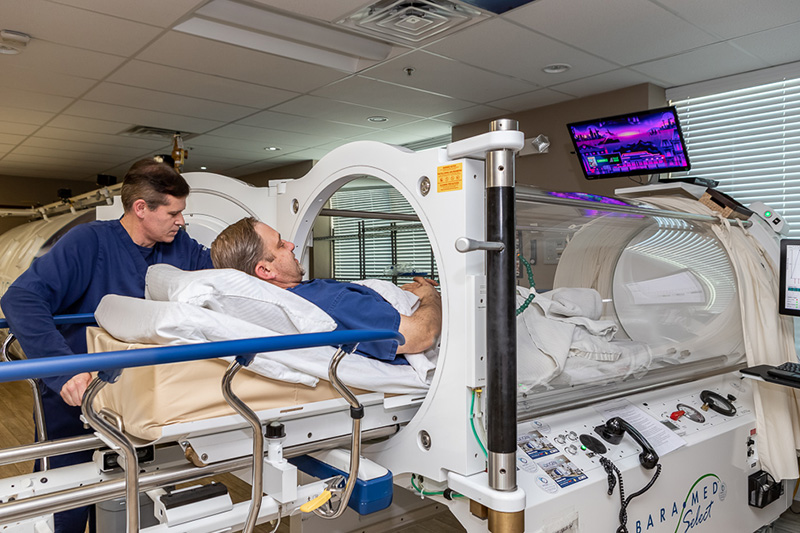History of Hyperbaric Oxygen Therapy (HBOT)
Since the origins of hyperbaric therapy and diving are closely tied, the use of compressed gas in medicine has ancient roots. While we don’t know much about the origins of diving, we do know that as far back as 4500 BC, free-diving (breath-holding dives) for mother-of-pearl was a distinct occupation.
In 1620 Dutch inventor Cornelius Drebbel invented the first true diving bell. It had an open bottom and relied on the pressure of water to keep air trapped within the bell. The bell would be lowered into the water by crane and had a ballast to keep the bell properly oriented. Air was pumped into the bell by a hose to keep fresh air within while excess gases would leak out from under the lip of the bell. As the bell sank deeper more air was pumped inside to keep the occupants comfortable. The bell was never meant to move under the control of the divers but served as an underwater base for free divers.
HBOT Preceded the Discovery of Oxygen
The first documented use of hyperbaric therapy came before the discovery of oxygen. In 1662, a British clergyman named Henshaw used a system of organ bellows to change the atmospheric pressure in a sealed chamber called a domicilium. This domicilium could create both hyperbaric and hypobaric (characterized by less than normal pressure) environments.
Despite lacking any scientific basis for his theories, Henshaw believed that acute conditions would benefit from increased air pressure, while chronic conditions would respond better to decreased air pressure. According to Henshaw, “In times of good health this domicilium is proposed as a good expedient to help digestion, to promote insensible respiration, to facilitate breathing and expectoration, and consequently, of excellent use for the prevention of most afflictions of the lungs.”
Henshaw was only providing increased and decreased air pressure without increasing oxygen concentration. Oxygen was not discovered until 1773 by Swedish pharmacist Carl Wilhelm Scheele, and the term “oxygen” was not coined until 1777 by French chemist Antoine Lavoisier.
Nearly two centuries later, in the 1830’s, there was a rebirth of interest in hyperbaric medicine in France. In 1834, French physician Junod built a hyperbaric chamber to treat pulmonary afflictions using pressures of 2-4 ATA and reported increased circulation to the internal organs, improvements in cerebral blood flow, and production of feelings of well-being.
Then in 1837, another French physician Pravaz built the largest hyperbaric chamber of that time. It was used to treat patients with pulmonary conditions including tuberculosis, laryngitis, tracheitis and pertussis, as well unrelated conditions such as cholera, conjunctivitis, deafness, menorrhagia, and rickets.
Hyperbaric Therapy in the United States
In 1860, the first hyperbaric chamber on the North American continent was constructed in Oshawa, Ontario, Canada, and a year later, Corning built the first hyperbaric chamber in the United States. This chamber was used to treat “nervous and related disorders.”
In 1877, French surgeon Fontaine developed the first mobile hyperbaric operating theatre or operating room that took advantage of a basic law of physics, Henry’s Law, which states that the solubility of gas in a liquid is proportional to the pressure of the gas over the solution. This chamber was recommended to facilitate the reduction of hernia, and for patients with asthma, chronic bronchitis, emphysema, and anemia. Within a three-month period, 27 operations were performed in this mobile hyperbaric chamber.
Moving into the 20th century in the United States, Orville J. Cunningham built a hyperbaric chamber in Lawrence, Kansas in 1921. There he treated victims of the Spanish influenza epidemic that swept the country. Cunningham theorized that atmospheric pressure or barometric factors were responsible for the higher mortality rates of those located at higher elevations. Cunningham reported remarkable improvements in patients who were cyanotic and comatose.
Unfortunately, one night a mechanical failure caused a complete loss of pressurization and all of Dr. Cunningham’s patients died. Although a tragic and a sobering lesson, this did not deter Cunningham’s enthusiasm for hyperbaric air. He went on to treat diseases such as syphilis, hypertension, diabetes mellitus, and cancer. He believed that anaerobic infections play a role in the etiology of all such diseases.
In 1928, Cunningham built the largest hyperbaric chamber in the world in Cleveland, Ohio. This “Hyperbaric Hotel” was a five-story high steel sphere at 64 feet in diameter. Each floor of this massive hyperbaric sphere had 12 bedrooms with all the amenities of a good hotel.
The growing awareness of Dr. Cunningham’s treatments prompted repeated requests by the Bureau of Investigations of the American Medical Association (AMA) to validate his claims regarding the effectiveness of hyperbaric therapy. Some believe he simply didn’t want to share or cooperate with the AMA and others believed he was a total fraud. The chamber was dismantled in 1937 and sold for scrap metal during World War II.
U.S. Military Advances HBOT Research
In 1939, the U.S. Navy began treating divers suffering decompression sickness with hyperbaric oxygen therapy. This was different than all of the previous uses of hyperbaric therapy which used only compressed air.
After World War II, the U.S. military conducted research which resulted in greater knowledge about survivable pressures. As a result, throughout the late 1950s and early 1960s, the use of hyperbaric oxygen therapy increased.
In the 1950s, Ite Boerema, a cardiac surgeon in the Netherlands, conceived the idea of “flooding” the body’s tissues with extra oxygen. He worked with the Royal Dutch Navy to perform experimental surgery on animals inside a hyperbaric oxygen chamber.
The Undersea Medical Society, an organization made up largely of Navy and ex-Navy physicians, was founded in 1967 in the United States. This nonprofit organization is now known as the Undersea and Hyperbaric Medical Society (UHMS). To address concerns about the lack of scientific progress and regulation, the UHMS formed a Committee on Hyperbaric Oxygen Therapy in the late 1970s, and this committee systematically reviewed all the available scientific evidence on HBOT. They came up with a list of conditions for which HBOT was likely beneficial. This list was accepted by insurance providers, including Medicare.
In 1972, Dr. Richard A. Neubauer opened the Ocean Hyperbaric Neurologic Center in Lauderdale by the Sea. Throughout his life, despite being viewed with suspicion by skeptics, Dr. Neubauer continued to treat and report on the effectiveness of hyperbaric oxygen therapy in the management of various central nervous system disorders. He is considered the grandfather of HBOT in neurology.
Today, thousands of hyperbaric oxygen therapy clinics dot the globe. More and more people are becoming aware of the many benefits of HBOT for conditions such as autism, traumatic brain injury, stroke, and many more.
From 4500 B.C. to the 21st century, hyperbaric oxygen therapy has come of age and taken its place in the treatment of a wide range of conditions. If you would like to venture further into the fascinating history of this therapy, we invite you to download this 2019 abstract: Historical Aspects of Hyperbaric Physiology and Medicine.



